One of my absolute favorite parts of springtime are lilacs. The aroma is indescribable. Sweet, floral, heady. Truly intoxicating, in a good way.
Not to mention, they are absolutely beautiful and so darling. And the color makes me so happy. And since they have a limited season (just about a month), I figured I had to incorporate them into a springtime recipe. Because lilacs are edible, in case you didn’t know that!
I have decorated cakes with lilacs before, but I have never incorporated them into an actual recipe. Until now. And I gotta say, making this Vegan Lilac Lemon Cake was the best decision I’ve made during these last two strange months.
If you’re looking for a more traditional lemon layer cake, this new Vegan Lemon Cake is out of this world!
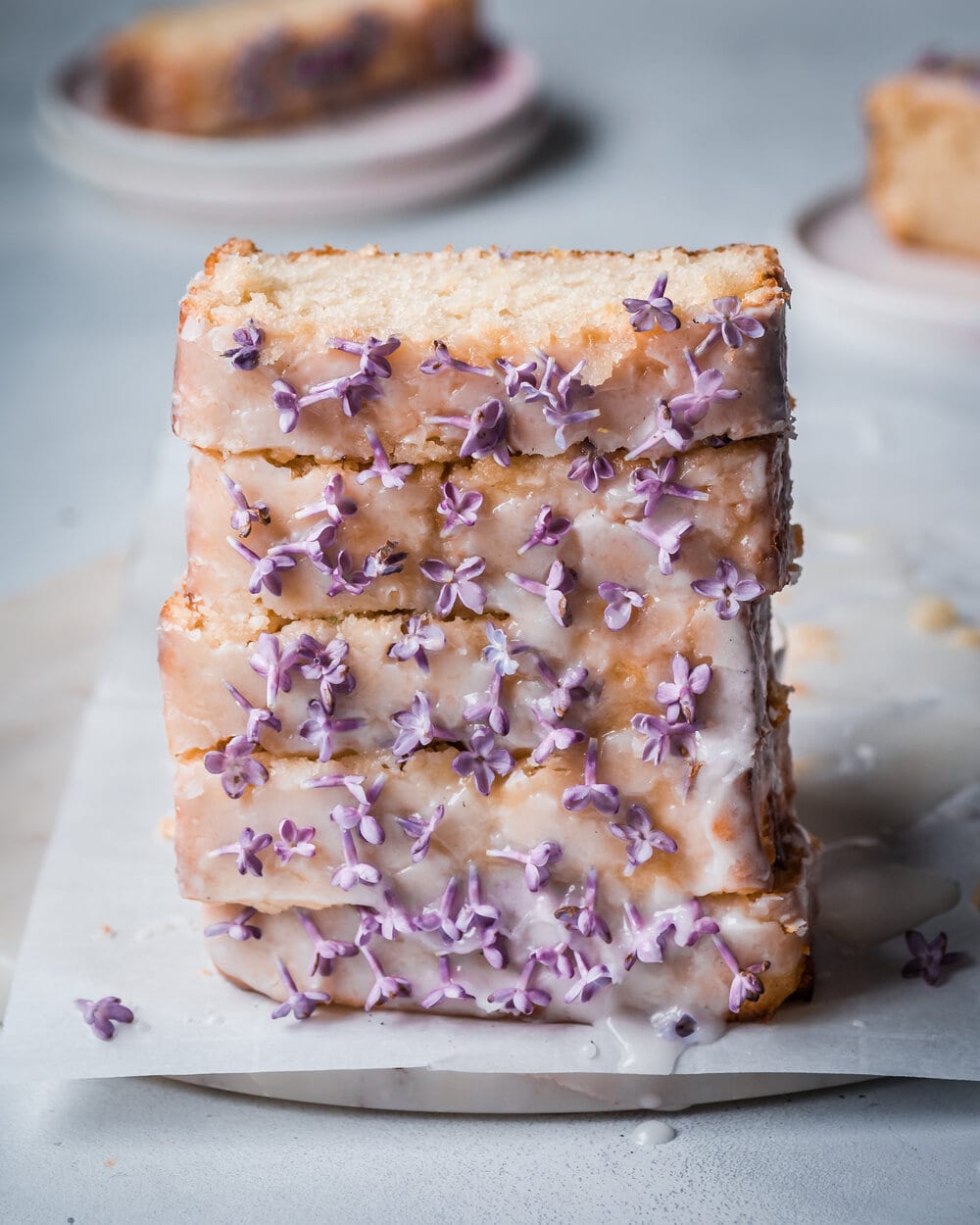
I thought about making an infused lilac syrup, but I wasn’t sure that would work in a cake, so I decided to make lilac sugar.
There’s a short blog post here on How to Make Lilac Sugar and it’s really quite simple. All you need is a jar, lilac flowers, and cane sugar or granulated sugar!
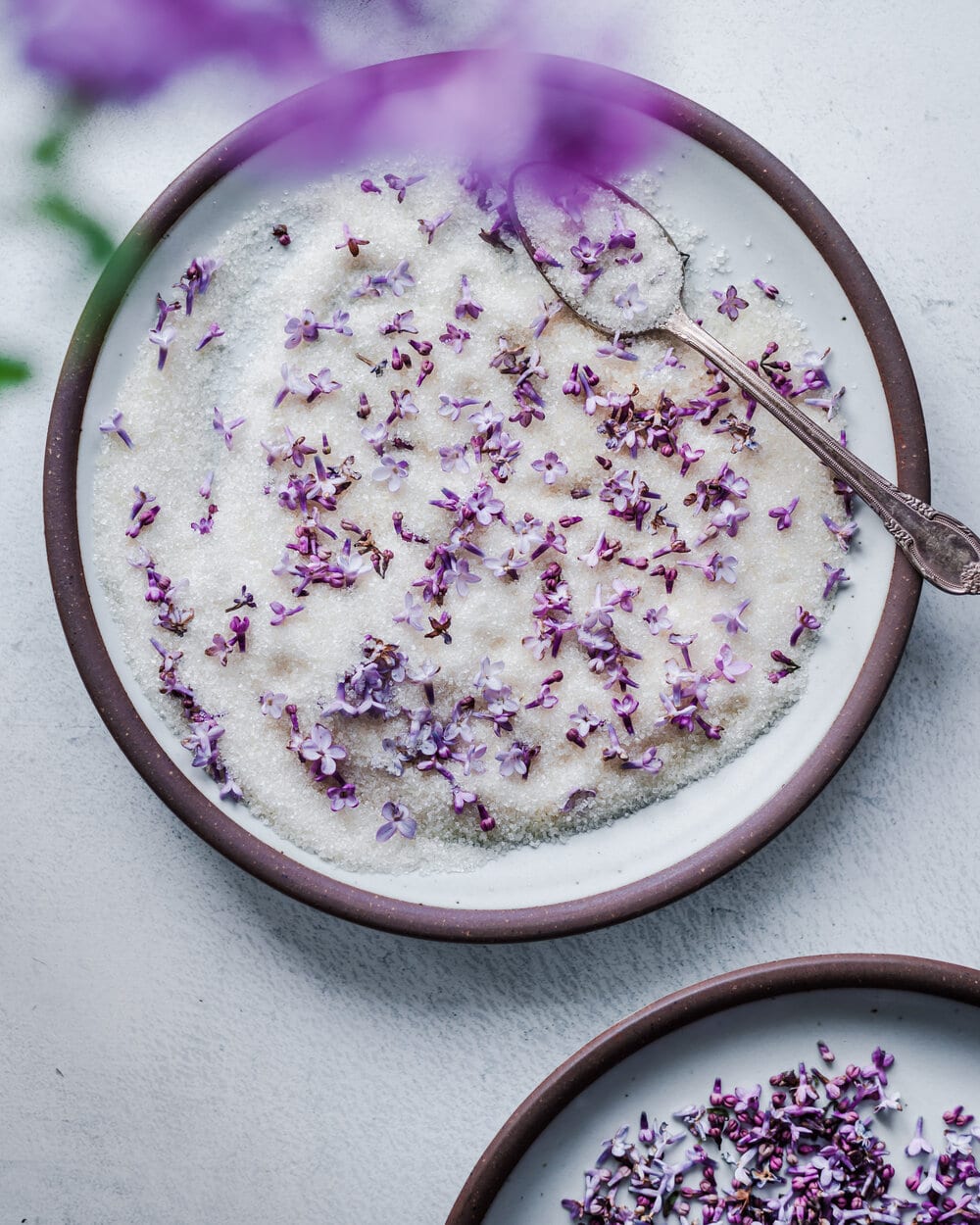
This is actually my absolute favorite cake now, and I am not exaggerating in the least. Don’t let the fact that it’s in a loaf pan deter you from thinking this is a cake. It’s just as cake-like as any three-layer cake. In fact, Max said this was the best cake I had ever made (and he’s been the prime beneficiary of my cake-baking over the last 10 years).
The texture is light and tender (and I didn’t even use cake flour!) yet extremely buttery, the flavors are sweet yet tart and tangy so it’s not overpoweringly sweet like some cakes, and of course, it’s so pretty! And the unique infusion of lilac sugar – it is such a treat. I don’t know how to describe it aside from subtle yet heavenly floral citrus flavor, and it’s quite unlike anything you’ve ever tasted before!
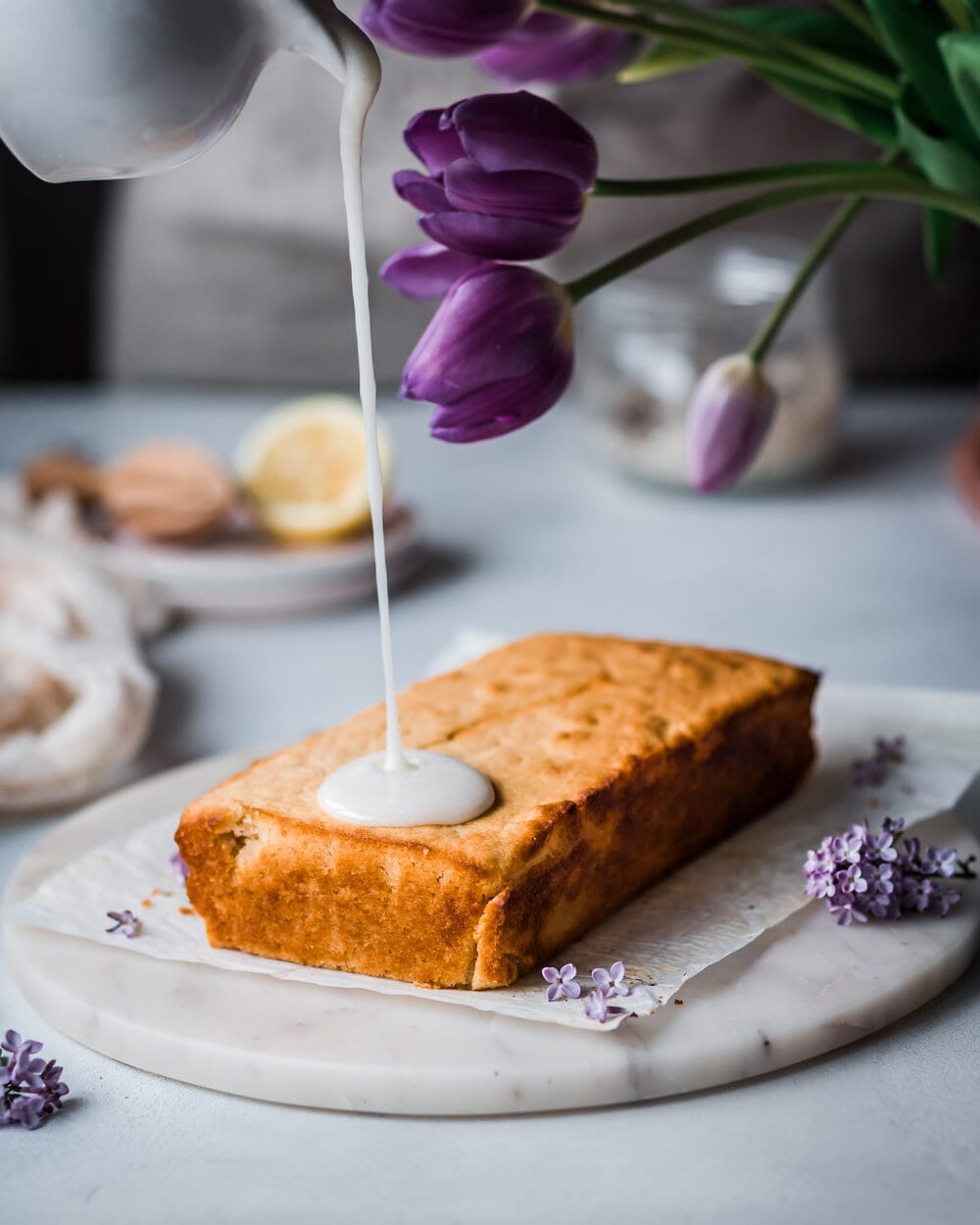
Ingredient Rundown
Vegan Butter
I wanted this cake to be light and lemony since it’s springtime, but I also wanted it to feel a little indulgent. Typically, with cakes, oil lends a lighter, more even crumb, whereas butter brings more flavor and richness but also some heaviness.
But, since I use dairy-free vegan butter that’s typically made with a blend of oils, it doesn’t bring the same heaviness that traditional butter sometimes does.
The combination of vegan butter with oil in this recipe lends a texture that is light and tender, but also rich and flavorful. When you take the cake out of the oven, it should be nicely golden brown on top, and when you slice into the cake, you’ll notice that the texture is a cross between a light feathery cake and a pound cake.
I don’t really know how else to describe this magical cake but it’s truly amazing. Light and tender yet buttery and rich!
Oil
As I mentioned earlier, I use a mix of vegan butter and oil in this recipe. Any oil should work in this recipe. I used sunflower oil, but if you want a more distinct flavor, you could try a high-quality, fruity extra virgin olive oil, which pairs beautifully with the lemon juice (just as it might in a lemon vinaigrette).
Lilac Sugar
If the light and tender yet buttery texture is the first star of the show, the second star of the show is the lilac sugar. Are you allowed to have two stars in one show (in one cake)? I think so.
The lilac sugar ever so delicately perfumes this whole cake with subtle yet pungent floral-citrus overtones that highlight the lemon flavors in this cake. It is truly the most unique and delicious cake I have ever made, so if you can get your hands on some lilacs and wait a few days to make the sugar, it is highly worth it.
Lemon Juice + Lemon Zest
This is a lemon cake, so we’re using a lot of lemon juice and the zest. 1/4 cup lemon juice and 1 tablespoon lemon zest to be precise. The result is a zingy lemon cake that’s perfectly tart yet sweet.
Also, please use FRESHLY SQUEEZED lemon juice. Since this is a lemon cake, you must use fresh lemon juice to get that lovely, bright lemon flavor; no plastic bottles of juice!
The lemon juice gets mixed into the plant based milk, forming something akin to vegan buttermilk. Along with the aquafaba (see below), it helps bring a lot of lightness to this cake.
Note: if you taste the raw batter, it might taste too lemony, but once it’s baked with the sugar, it all comes together.
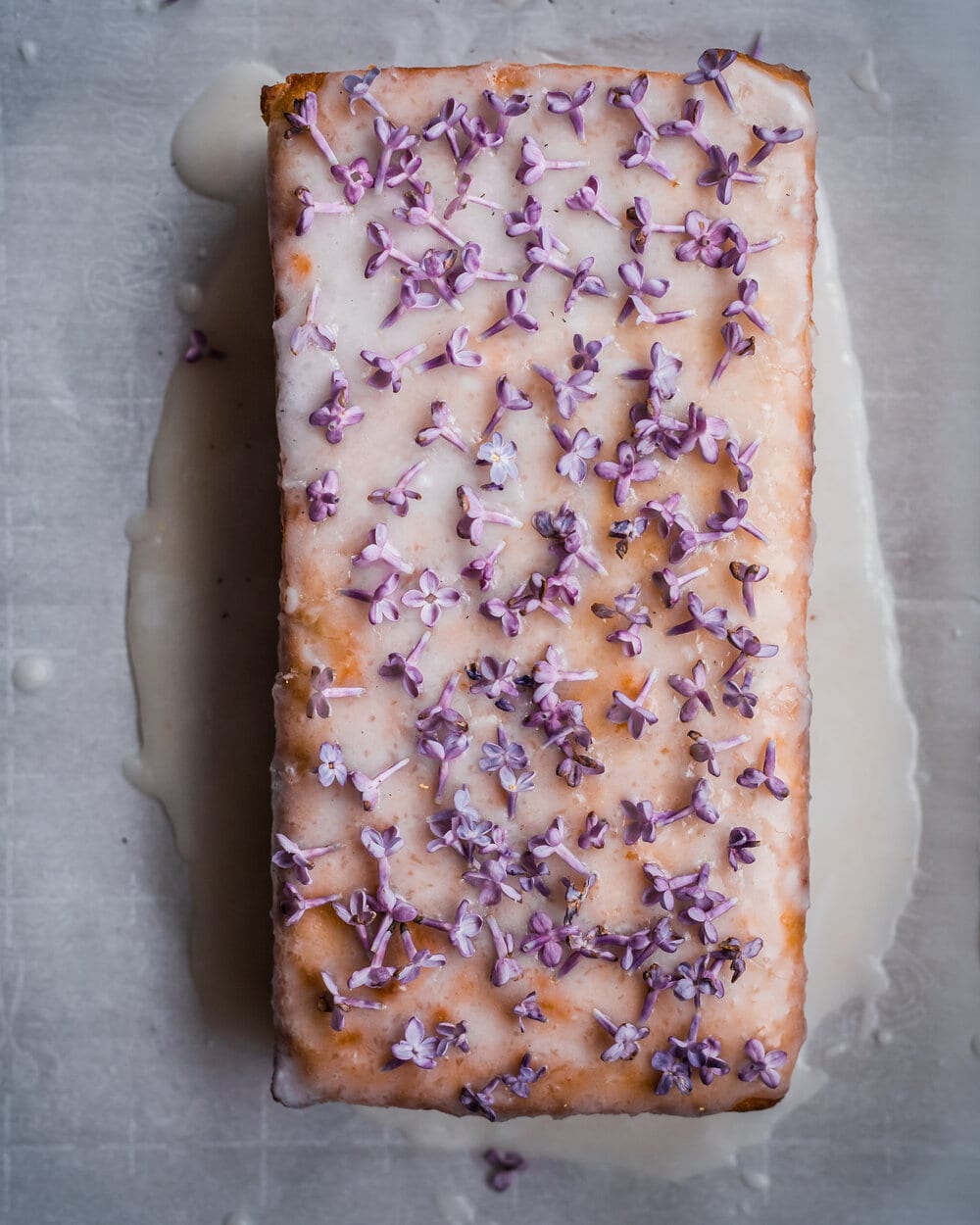
Aquafaba
The type of vegan egg substitute you use should depend on the type of baked good you’re making and your desired texture. I have a whole blog post on the topic of vegan egg substitutes in baking (including a handy dandy infographic) if you’d like to learn more!
With a cake, I want the texture to be airy and light, so I like to rely on aquafaba, which is simply the liquid leftover from cooked chickpeas.
When you lightly whip aquafaba, as is done in this recipe, it turns foamy and light, which then helps to create a light and fluffy texture and gives a nice lift to cakes.
All-Purpose Flour
While I love making cakes with cake flour, as it yields the the lightest texture, I don’t have any cake flour during this weird lockdown time, and to be honest, the other aforementioned ingredients make this cake so light and tender that it’s not needed.
I haven’t tested this recipe with anything besides all-purpose flour, so I can’t be of too much help here.
If you typically avoid gluten but can tolerate it (i.e., you’re not allergic or seriously intolerant), make this cake recipe as written! I promise your taste buds will thank you. That said, if you are allergic to gluten and still want to make this cake, a 1:1 gluten-free all purpose baking flour is your best bet.
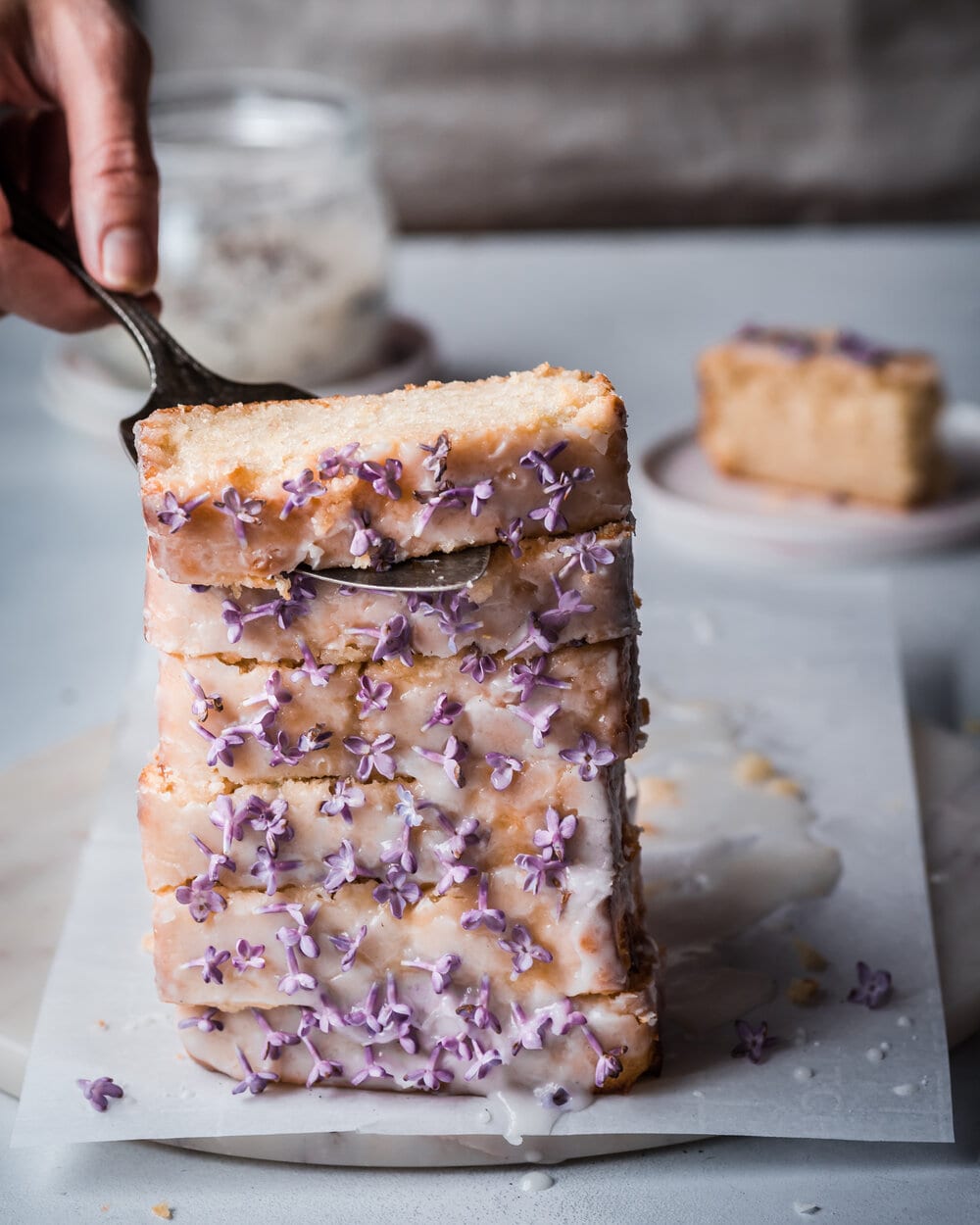
Tips for Making this Vegan Lilac Lemon Cake
Zest the lemons, then juice them!
In recipes that call for lemon zest and juice, as in this recipe, remember to zest your lemons first before juicing them.
No overmixing!
When mixing the dry and wet ingredients, be sure to not overmix! Mix until the batter is just combined, and it’s okay if there are light traces of unmixed flour remaining.
I use an electric mixer on low speed (since I already use it for the aquafaba), which I find makes me less tempted to over-mix than if I were using a whisk and needed to exert more effort.
The directions instruct you to add the dry ingredients to the wet ingredients in two batches. During the second batch, I switch from the mixer to a silicone spatula so that I don’t overbeat the batter.
Don’t over-flour it!
This recipe calls for 1 3/4 cups all-purpose flour, but the more important part is to weigh or measure your flour properly. As you might have seen in my fan-favorite Banana Bread recipe and Youtube video, I am a strong proponent of using a digital scale for all baking purposes, as it yields the most exact results.
I am just going to repeat the advice here again :)
But if you don’t have a digital scale, please, DO NOT SCOOP YOUR FLOUR STRAIGHT OUT OF THE BAG. This always results in getting too much flour in your measuring cup, and too much flour = dry cakes.
Instead, use the spoon and level method. Spoon your flour out of the bag/jar into the measuring cup until almost full, then use a butter knife to level it off.
If you think I’m being overly cautious, I have tested this numerous times using a digital scale. Usually, when you scoop 1 cup of flour straight out of the bag/jar, you’re actually scooping closer to 1 1/4 cups in grams. This makes a difference in baking!
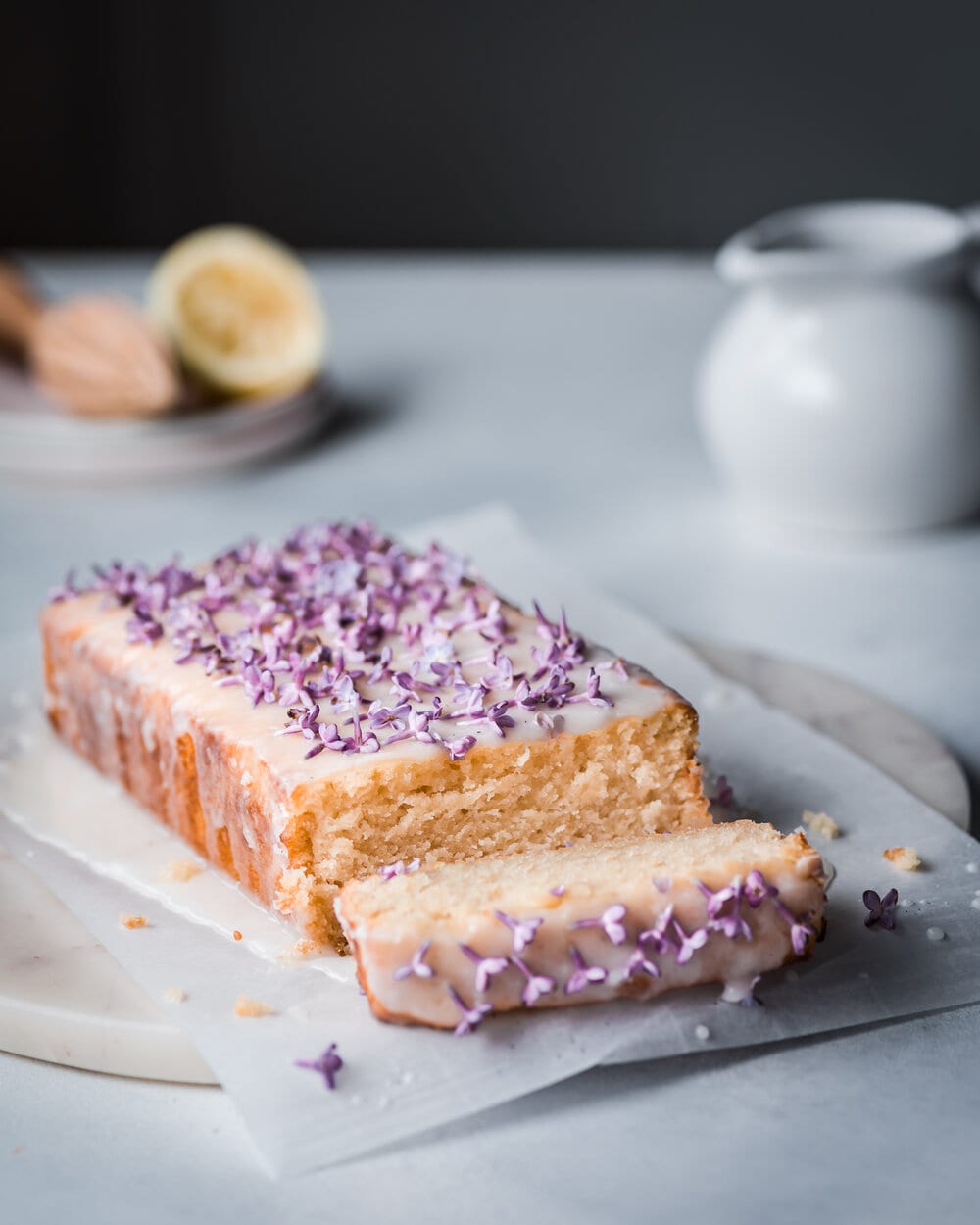
Substitutes for this recipe
Lilac Sugar
The lilac sugar does take a few days to rest, so if you want to make this recipe as written, you’ll need to plan this out a few days in advance. If you just really want to make this cake ASAP without the lilac sugar, just use regular cane/granulated sugar. You won’t have that lovely subtle aroma from the lilacs, but it’ll still be a delicious, bright and zingy lemony cake. And you can still decorate it with lilac flowers (which are edible!).
OR, if you have dried lavender flowers, lavender extract, or culinary lavender, you could potentially turn this into a lavender lemon cake. I haven’t tried this myself, but the interwebs abound with lavender lemon cakes, so that is an option. I’d fold in about 1 tablespoon dried lavender flowers or just a few drops of lavender extract into the cake batter.
Lemon Glaze
The glaze makes this cake extra pretty and tasty, and requires just three ingredients. But if you are limiting your sugar intake, go ahead and omit the glaze.
The glaze calls for coconut yogurt because I absolutely love the way the tangy coconut yogurt pairs with the lemon. But if you don’t have coconut yogurt, I recommend substituting with a tablespoon or two of plant-based milk.
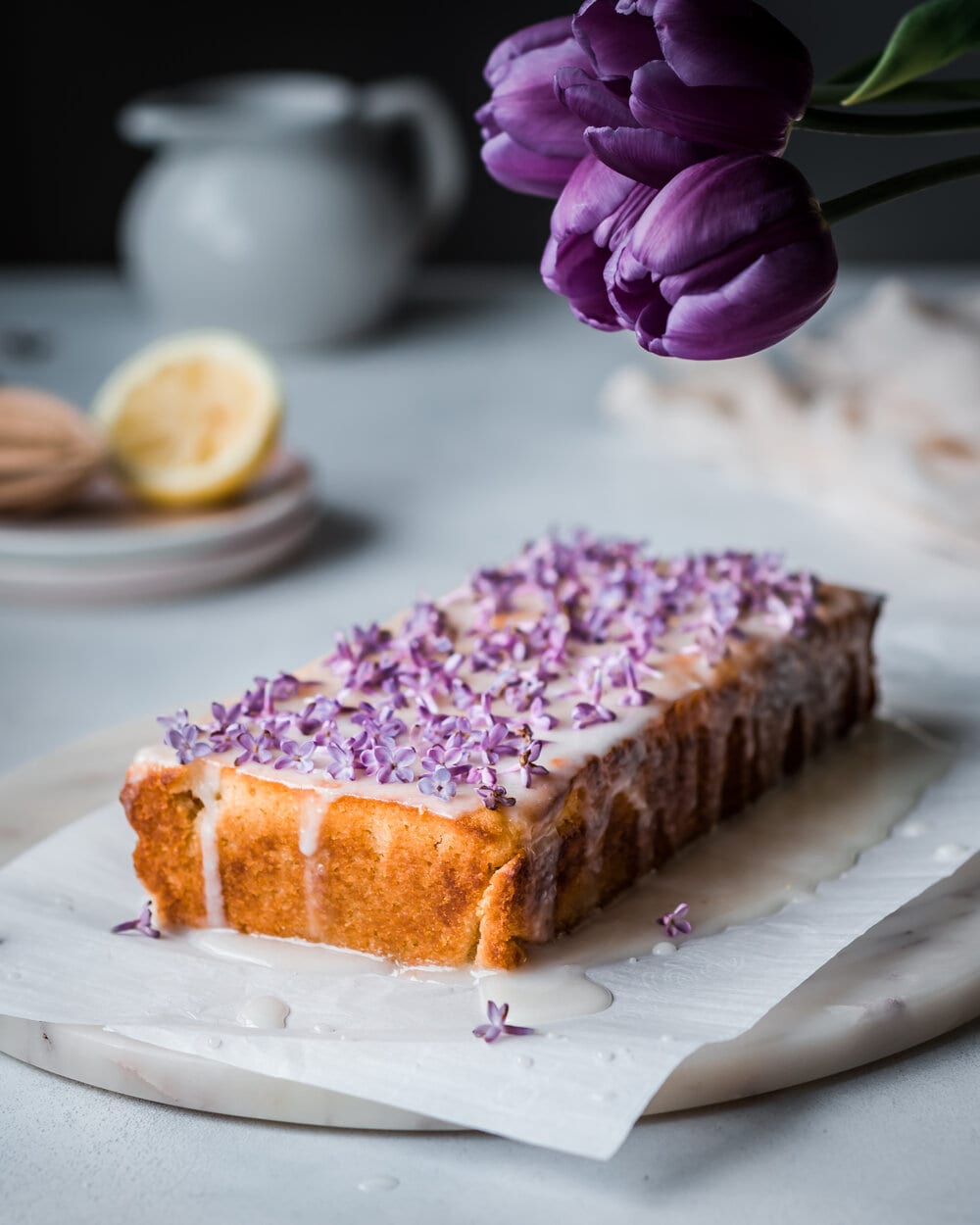
If you give this Vegan Lilac Lemon Cake recipe a try, be sure to tag me on Instagram with your recreations and please comment with your feedback below! And enjoy this little video :)

Big Vegan Flavor
Techniques and 150 recipes to master vegan cooking.
Vegan Lilac Lemon Cake
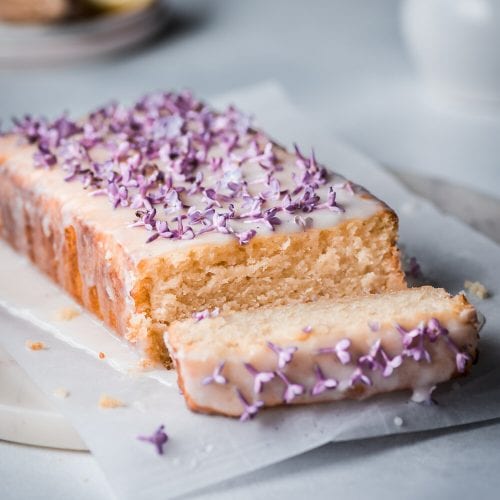
Ingredients
- 1/2 stick vegan butter (56g or 1/4 cup), softened at room temperature
- 120 mL (1/2 cup) unsweetened plant-based milk (I used oat milk), at room temperature
- 60 mL 1/4 cup lemon juice
- 60 mL (1/4 cup) aquafaba (the liquid from a can of chickpeas)
- 56 g (1/4 cup) neutral-tasting oil such as sunflower oil, or extra virgin olive oil
- 120 g (1/2 cup + 1 tablespoon) Lilac Sugar (or organic cane sugar)
- 1/2 tablespoon pure vanilla extract
- 1 tablespoon lemon zest (1 medium-to-large lemon)
- 210 g (1 3/4 cups) all-purpose flour
- 1/4 teaspoon baking soda
- 1 teaspoon baking powder
- 1/4 teaspoon fine sea salt
- Toppings (optional): Lemon Glaze (recipe below) and lilac flowers
Instructions
- Take the butter out of the fridge to soften and take the plant-based milk out of the fridge to come to room temperature.
- Preheat the oven to 350°F/175°C. Line a 9x5-inch (23x13 cm) or 8x4-inch (20x10 cm) loaf pan with parchment paper.
- Zest the lemon(s) to get 1 tablespoon of zest (1 medium-to-large lemon). Set aside.
- Make the vegan buttermilk. Combine the plant-based milk and lemon juice and stir. Set aside to curdle.
- Prepare the aquafaba. Pour 1/4 cup liquid from a can of chickpeas into a small bowl. With a handheld electric mixer (or stand mixer), beat the aquafaba on medium speed until it‘s foamy throughout, 45-60 seconds.
- Cream the wet ingredients. Add the softened butter, oil, and Lilac Sugar to a large bowl. Using the mixer, beat until the ingredients are well incorporated and starting to get fluffy, 60 seconds or so. Add in the vegan buttermilk, whipped aquafaba, vanilla extract, and lemon zest. Mix until just combined, 15-20 seconds.
- Whisk together the dry ingredients. Add the flour, salt, baking soda, and baking powder to a medium bowl and whisk well to ensure the leaveners will be evenly distributed throughout the cake.
- Add half of the flour mixture into the butter-sugar mixture, beating on low speed until just combined, taking care to not over beat. Add the remaining flour mixture and beat until mostly smooth, then switch to a silicone spatula to finish combining. Once the cake batter is mostly evenly combined, stop mixing! Overmixing can cause the cake to become dense or dry. The batter should be fluffy and a bit bubbly at this point.
- Pour into the prepare loaf pan, and smooth the batter out on the top using a silicone spatula.
- Bake for 35-45 minutes until a toothpick inserted into the tops/center comes out clean and the top is golden. If the top starts to brown early, loosely tent it with foil. I baked mine for exactly 40 minutes, and it was perfect.
- Transfer cake to a wire rack and cool for 15-20 minutes. Then use the parchment paper handles to lift the cake out of the pan and onto the wire rack. Once cooled, drizzle with the lemon glaze. If desired sprinkle some lilac flowers (shake them first to make sure there are no bugs hiding) on top.
Notes

Big Vegan Flavor
Techniques and 150 recipes to master vegan cooking.
Lemon Glaze
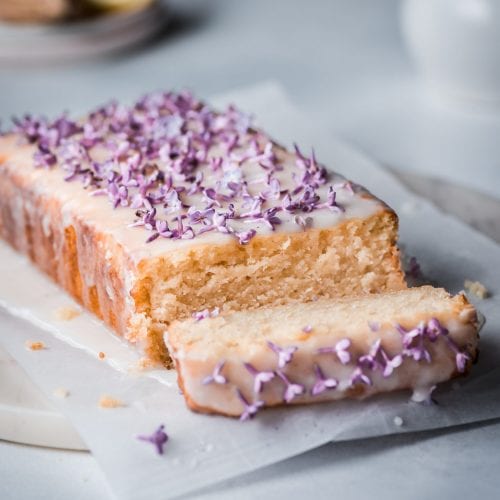
Ingredients
- 120 grams (1 cup) organic powdered sugar
- 2 tablespoons coconut yogurt
- 1 tablespoon lemon juice, plus more as needed
Instructions
- Mix together all ingredients in a small bowl with a whisk until you have a thick yet pourable glaze texture. If you want it to be thinner, add more lemon juice (or a spoon of plant based milk). If you want it to be more lemony, add a bit more lemon juice or some lemon zest.

Big Vegan Flavor
Techniques and 150 recipes to master vegan cooking.
Lilac Sugar
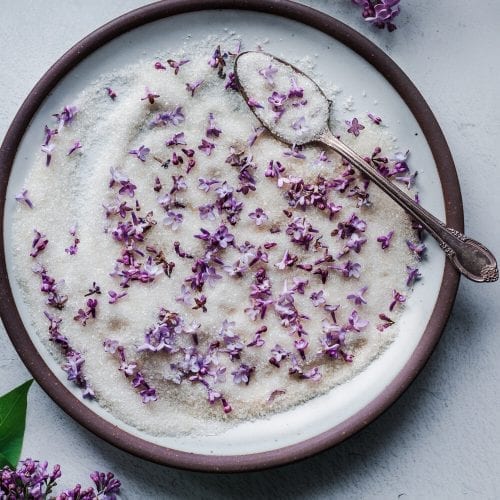
Ingredients
- 1 cup (190g) organic cane sugar or granulated sugar
- 1/4 to 1/2 cup of lilac blossoms
- 1 glass jar
Instructions
- Shake the lilac bunches to make sure there aren’t any small bugs hiding in there. Then delicately remove individual lilac blossoms from the stems.
- Fill your jar with about 1/4 of the sugar. Then add a large handful of lilac blossoms. Repeat in layers with the sugar and lilac blossoms.
- Seal the jar and shake it up. Store in a cool, dry, dark place for at least 2 days. Make sure you shake the jar at least once a day to help evenly distribute the lilacs amongst the sugar.
- The sugar will get a little damp from the lilacs, so after a few hours or the next day, I like to dump the lilac sugar out on a parchment paper-lined tray or flat surface for an hour or so. That way the sugar dries up and loses the excess moisture. Return the lilac sugar to the jar and give it a shake.
- After at least 2 days or (or up to a week), pluck or sift out out the flowers. You can use it in recipes (as this cake), in tea, or as a body scrub!
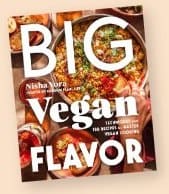



This was delicious! Very special recipe to make for the special people you love!
Awesome, Rebecca. Thanks for your comment and for taking the time to review!
Can I substitute the vegan butter for more olive oil? We don’t have a good brand as yours in my country.
Non-vegan friends were shocked to know it was vegan! I didn’t end up using lilac, but it was still lovely as a lemon loaf
This cake was moist and delectable! The flowers made it super pretty and perfect for spring! Such a cute (and delicious) dessert!
I have made this cake twice, making the homemade lilac sugar both times. While I loved the lemony flavor and texture of the cake, I couldn’t taste the lilac flavor either time.I do have some culinary dried lavender that I will try next time.Thank you for sharing your wonderful recipes!
Thanks for sharing! Does the lilac sugar keep long?
This looks so good! Do you use this cake base for any other recipes?
Sooo yummy!! Perfect for a small spring potluck dish that’s pretty, light and tasty! Can easily sub didn’t glaze flavors by switching yogurts!
I made the sugar and the lilacs turned brown and started smelling super awful just a few days into making it… took flowers out, sugar sat out a week and that sugar just smells bbbaaaaad. Any tips on what I might have done wrong?
Are there any adjustments for making this at altitude? (10,000 ft) Thank you!
HiI made this today for my Moms 80th Quarantine Bday tomorrow. It looks amazing and I made it in a flower-shaped pan. The glaze is clear almost. It was white in the bowl but when I poured it on it is clear. Any suggestions or reasons why? Thanks!
Hi Ali, I’m glad it looks amazing. Often, sugar glazes like this turn clearish when they dry. It’s totally normal!
I made this cake yesterday and it was SO good! A big hit with my boyfriend and it goes really well with coffee.
I didn’t have any lilacs but I did have dried culinary lavender at hand. I used the amount of sugar the recipe calls for with 1 tablespoon of lavender. I kind of ground up the lavender a little with a mortar and pestle (or you can use your fingers) this way I wouldn’t be biting into whole pieces of lavender. I put both the sugar and the lavender in a jar and shook it up real nice to get it all incorporated. I used this instead of the lilac sugar and it worked great!
I also don’t own a mixer but did it just as fine by hand with a whisk.
I baked for 40 minutes which was the perfect amount of time.
I also didn’t have coconut yogurt for the glaze. I used almond milk and it came out just fine.
This recipe was delicious and I’ll definitely be saving it for future use. Thank you Nisha!
Thank you so much for this delicious recipe!! Loved the creative toppings and the infused lilac sugar :)
Hi
I bought all the ingredients today and then properly read the recipe and I don’t have a mixer face palm! Do you think mixing with a wooden spoon will do the job? Thank you!
Aww haha I have done that! For the aquafaba, you’ll want to use a whisk and beat it by hand until it gets foamy – it will likely take longer than the 45-60 seconds it takes with a hand mixer. I would also cream the wet ingredient (step 6) using a whisk. Then you can switch to a wooden spoon to incorporate the dry into the wet ingredients. Hope that helps!
Thank you!!! :)
Hi Nisha,I tried the cake and it turned out amazing! Except that I used the lavender instead of the lilac flowers. Later I read the controversy about using the essential oils. Also I think 1/2 tsp of the oil was a little over powering for my taste. I’d probably do a few drops (2-3). But I am curious to know if you’ve used essential oils in any of your other recipes.
Thanks!
Hi Nisha, I’m so excited to try this! I see in step 6 you say to add the vegan buttermilk… but then also in step 8, would you clarify?
Whoops! Thanks for catching that :) I removed it from step 8. It should be in step 6. Thanks Sarah!
Where can I buy lilac flowers for cooking? Do you grow them yourself?
Hi Laura, I live in a NYC apartment and don’ t have a garden so I certainly can’t grow them myself haha. But they are available at the local farmers market during this time.
Hi Nisha! I live right outside NYC- are they still having the farmers market? I can pickup lilacs today and bake cake
Yes, they are! I went to the one in grand army plaza in brooklyn this morning. I also know the union square one is open. More info can be found on their site: https://www.grownyc.org/blog/schedule-changes
Just be sure they’re organic. Tons of pesticides are used in the floral industry.
No Lilacs around so I am attempting with a little lavender! Keeping my eyes peeled for some lilac to use next time…
I think lavender would be a great addition! Let me know how it goes :)
This cake looks stunning and I’d love to make it in time for Sunday. However I’m vegetarian and am wondering if I can substitute eggs for the aquafaba? :)
Thanks!
Did you read her post? It says to use aquafaba..
I was wondering this too — I think 1/4 cup aquafaba is equivalent to a little more than one egg
Hi Laura, 3 tablespoons aquafaba is equivalent to 1 whole egg, so 1/4 cup would be 1 extra large egg. As I mentioned in reply to Rachel, I haven’t tried this cake with another egg substitute and since I haven’t baked with eggs in years, I can’t say for certain that it would work, but based on my baking knowledge, it should work fine.
Hi Rachel, I haven’t tried this with anything besides aquafaba and haven’t baked with eggs in almost 4 years, so i can’t say for sure if it would work but theoretically it should, since the the aquafaba acts as a binder and leavener in this recipe, similar to eggs. The aquafaba brings a lot of lightness to this cake, so if you do have a can of chickpeas lying around in your pantry, I highly recommend using the liquid from the can for the aquafaba!
Hey! What can I substitute Aquafaba with? Also, can I make it without lemon glaze and lilac sugar?
Hi Radhika, I haven’t tried any substitutes for the aquafaba so I am not entirely sure. Aquafaba is one of the ingredients that brings a lot of lightness to this cake in addition to some binding, and other egg substitutes like flax eggs, mashed bananas, or applesauce don’t do the same. I haven’t tried this, but you could try chickpea flour mixed with water. 6 tablespoons of chickpea flour with 6 tablespoons of water, mix until you have a thick and creamy mixture. And yes you can make it with regular sugar so it will be a nice lemon cake and the glaze is optional.